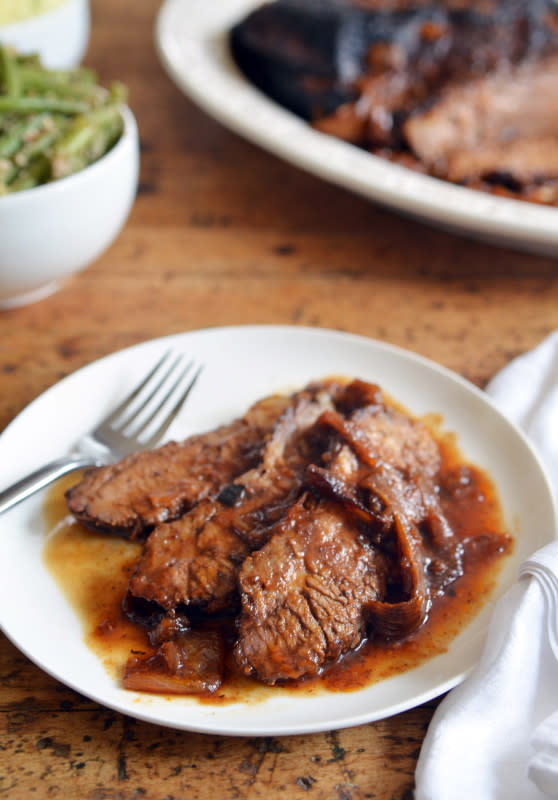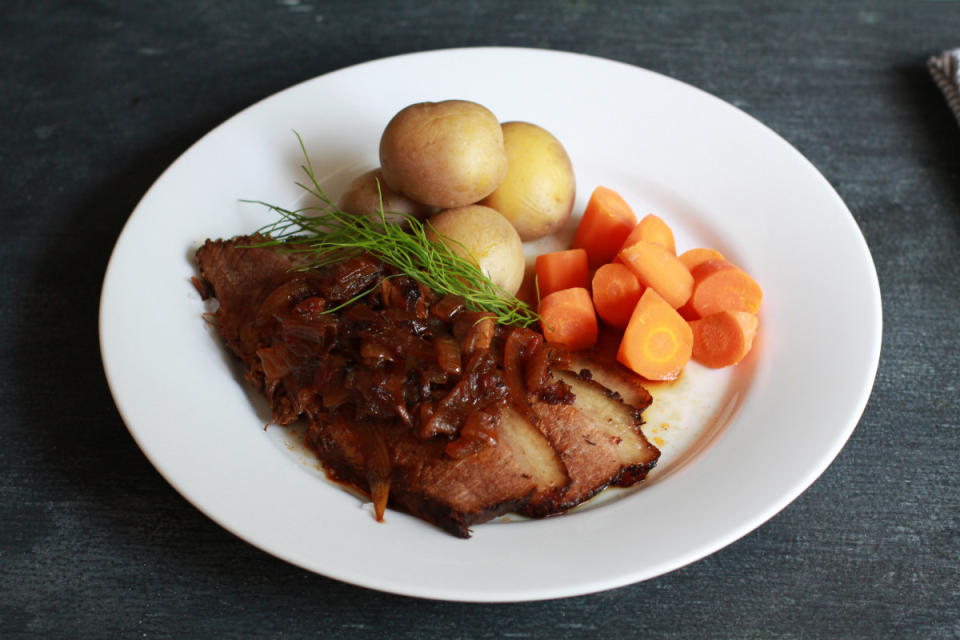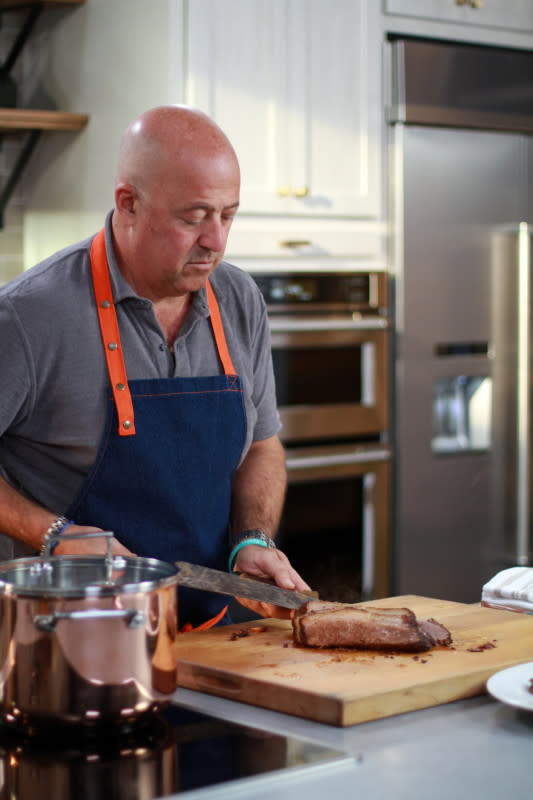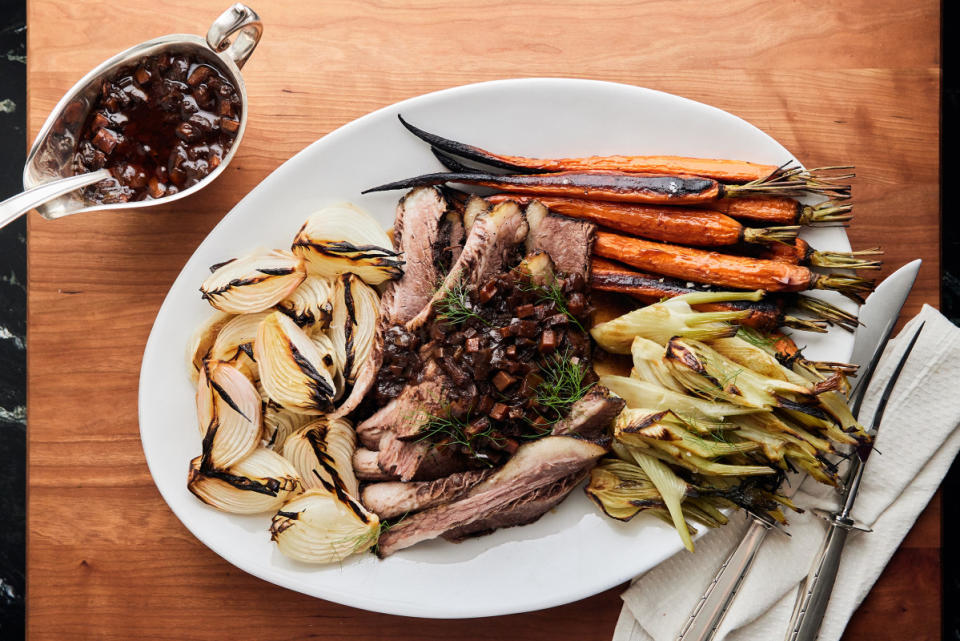The Absolute Best Way to Make Tender, Juicy Brisket, According to Chef Andrew Zimmern (and His Grandmother)

- Oops!Something went wrong.Please try again later.
Andrew Zimmern and sliced brisket
Andrew Zimmern’s original go-to brisket recipe dates back to his grandmother. The classic braised brisket with fennel and onions recipe has been a staple in the celeb chef’s holiday celebrations for generations. As happens with many family recipes, Zimmern has added his tweaks over the years and makes the recipe “slightly different these days,” though much of the technique stays the same.
“[Brisket is] extremely difficult to cook. But if you follow a couple of easy principles, it's not that hard,” Zimmern tells Parade. Over the years, Zimmern has made many a brisket, including for holidays, parties, TV shows and more. And that's not where his love of brisket ends. He even created "Brisket Week," where he shared what to do with all the tender, juicy leftovers. With all of this knowledge and Passover fast approaching, we knew Zimmern was the perfect person to show us how to make the best brisket.
Related: 8 Easy Passover Recipes
How to Shop for Brisket
When you go to the store, you might have a few brisket options: the point (sometimes called the crown), the flat and whole brisket. The point is the thicker, fattier portion and the flat is well, flatter and more even, typically about three or four inches thick versus the seven- or eight-inch point.
Although the flat and the point cook at different speeds, Zimmern still likes to cook a whole brisket. If all you can find is a flat, that will work, too, but Zimmern prefers a whole brisket because it adds a little extra insurance because of the fattier point. The flat is "very lean, and you end up with very little leeway on nailing it just right,” Zimmern says.
Related: 59 Happy Passover Greetings
What Size Brisket Do I Need?
When you’re at the grocery store, try to avoid giant briskets (like 15 pounds) because they are difficult to cook evenly. If you have a big crowd to feed, Zimmern recommends opting for two smaller briskets—but this guide will focus on a single 6- to 9-pound untrimmed brisket.

Madeline Hill
How to Cook Brisket
Now that you know exactly how to choose the right brisket, it’s time to get cooking. Here are Zimmern's top tips.
1. Let It Come To Room Temperature
Like most meats, it’s best to temper it first (meaning, take the meat out of the fridge and let it come to room temperature). According to Zimmern, this process will take about 90 minutes. This step will help make sure that the meat cooks evenly. “If you put a cold brisket in the oven and seal it and then start the braising process, it's like putting an ice cube wrapped in a blanket in the oven. It's just going to take longer to get tender,“ Zimmern says. While you're waiting for the meat to temper, preheat your oven to 275° or 300°. Zimmern prefers the former for a low and slow cook, but if you need to speed things up a bit, 300° works too.
Related: 7 Best Passover Desserts
Don’t Trim Off the Fat
One of Zimmern’s biggest chef takeaways is not to trim the fat off ahead of time. The fat is full of flavor, which has “too much value” to slice off before cooking. Once tempered, take your brisket out and feel the top of it for “big chunks of extraneous fat,” then slice those chunks off with a small sharp knife. Zimmern advises leaving the rest of the fat on the meat because it will melt into the brisket as it cooks. If there's any fat left after cooking, Zimmern also has a plan. “When I'm slicing my brisket to serve hours later, that's when I can trim that fat off. It's already done its job,” he says.
Always, Always, Always Pre-Season
Zimmern changes up his brisket methods about every ten years, but right now he's in his herbes de Provence era. There's a range of ingredients included in this French spice blend, but it often includes dried rosemary, tarragon, marjoram and thyme. If you don't have herbes de Provence, Zimmern suggests using a mix of dried thyme and rosemary. And no matter what spice blend you use, be sure to season the brisket generously with kosher salt and freshly ground pepper.
Sear and Deglaze
After seasoning, Zimmern gives the brisket a good sear. He heats some high-temperature oil (like grapeseed) in a roasting pan set across two burners. When the oil shimmers, he adds the brisket and cooks it until it's browned, then flips it and sears the second side. After the meat is seared, Zimmern moves the brisket to a platter. While the brisket rests, he sautées vegetables (whichever type you prefer, depending on which recipe you’re following) in the roasting pan with tomato paste and a bouquet garni (a bundle of herbs tied with kitchen twine). Carrots, brussels sprouts, onions and fennel are all great veggies to consider cooking alongside your brisket.
Next up? A bottle of red wine for deglzing the pan. The wine will pick up all the browned bits in the roasting pan from the brisket and the veggies, which will add flavor to the dish. Zimmern likes to use red wine because it adds richness to the brisket and also helps tenderize the meat. “When [the wine] starts simmering, I push my vegetables to the side, and I put my brisket in, and then I cover the pan with foil, and I put it in a 275° oven,” he says.

Madeline Hill
How Long Should You Cook Brisket?
Zimmern often avoids this question because the answer really depends on your brisket. Some briskets are short and stout, taking seven to eight hours, while others are long and thin, and cook in five to six hours. To make sure you get it right, Zimmern recommends letting your brisket cook for five hours, and then checking it each hour after that for tenderness. He starts to really pay attention when an internal thermometer reads 165° when inserted into the thickest part of the brisket. For a braised brisket (vs a smoked brisket) you're looking for a final temperature of 180°.
Having trouble figuring out exactly how to get the temperature of the meat? Zimmern can help. “The best thing to do is to pick a spot about two inches up from the end of the flat. Go about two, three inches in,” he says. Then, grab a cooking fork (the kind with the two long tines) or a pair of sturdy tongs and turn the brisket four times. If you’re able to turn it and the meat is tender, then your brisket is ready to be taken out of the oven.
A 9- to 10-pound brisket will usually take 6 hours at 300°. And just because the brisket is braising in wine, know that it's still possible to overcook it. “After a while, the absorption of liquid has tapped out. The fat is gone from the meat itself, and then every minute afterward that you're cooking it, it's getting drier and drier, even though it's sitting in liquid,” he says.
Let it Rest
Once the brisket is finished cooking, it's time for a rest. Zimmern’s rule of thumb is to let the brisket rest for one hour, minimum. If you have a little more time or are taking the brisket to a dinner party, you can cook it the day before, a method Zimmern likes a lot because the meat cools in the liquid and rests in the fridge, which allows all the flavors to meld and mingle.
Related: The Absolute Best Way to Cook a Tender, Juicy Leg of Lamb, According to Australian Chef Curtis Stone

Madeline Hill
The Best Way To Serve Brisket
To slice your finished brisket, separate the two main parts. The flat and point have protein strands at different angles and you want to cut the meat across the grain for the most tender slices.
Sprinkle the brisket with salt and pepper once again (but don’t overdo it, it will suck out the moisture). You can even place pepper grinders on the table so guests can season to taste. To plate, arrange the sliced brisket on a platter, and place the vegetables around the meat. You can make a simple pan gravy with the liquid in the roasting pan and pour that on top of the brisket.
If you’re using the overnight method, Zimmern says, “One of the benefits of refrigerating it was that I could take away all the fat. All the fat rose to the top, I was able to take it off with a spoon in my hands.” To serve the next day, he takes the cold brisket out of the liquid, wraps it well, puts it in the oven and reduces the liquid to make a tasty sauce. Throw in a few tablespoons of red wine vinegar (note: a very small amount) to add a little tartness to the sauce to offset the sweeter vegetables. You then reheat the brisket at 225° for 90 minutes.
Related: The Best Latke Tips, According to Celebrity Chefs

Magnolia Network
What Are the Best Sides to Serve with Brisket?
What should you serve with your perfectly made brisket? Zimmern loves crispy potatoes of some sort, especially potato pancakes. Green vegetables or a winter salad with a citrus vinaigrette are also some complimentary go-tos. Get started with these great recipe ideas.
Extra-Crispy Roasted Potatoes
Crispy Parmesan Potatoes
Miso-Maple Roasted Carrots
Balsamic Roasted Broccoli
Up next: How to Cook Prime Rib Like a Pro, According to Pat LaFrieda, America's Most Celebrated Butcher

